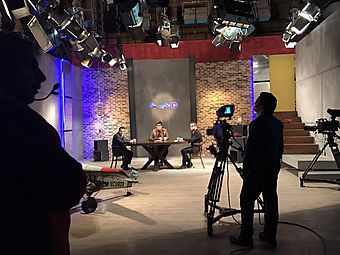Charkh facts for kids
Quick facts for kids Charkhچرخ |
|
|---|---|

A shot from behind the scene of Charkh TV program by Milad Nouri and Shahriar Rabbani
|
|
| Created by | Maryam Firoozi |
| Starring | Shariar Rabbani, Milad Nouri, Iman Vakili as host |
| Country of origin | |
| Original language(s) | Persian |
| No. of episodes | 200+ |
| Production | |
| Executive producer(s) | Mahdi Boroomand |
| Running time | 50 minutes |
| Release | |
| Original network | Channel 4 (Iran) |
| Original release | September 2015 |
Charkh (Persian: چرخ which means "wheel" in Persian) is an exciting Iranian TV show. It's a talk show, where people discuss interesting topics. This show is all about science and has been on TV since 2015 on IRIB TV4. Each episode is about 50 minutes long and explores different scientific ideas.
About the Show
Charkh is broadcast live across Iran almost every evening. It airs six days a week, making science a regular part of many people's lives. The show aims to make science fun and easy to understand for young people in Iran.
Who Hosts Charkh?
The main presenters of Charkh are Shariar Rabbani and Milad Nouri. They guide the discussions and help explain complex ideas. Each episode also features special guests. These guests are often scientists or experts from different fields in Iran.
What Topics Does Charkh Cover?
Charkh explores a wide range of science topics. The show invites experts to talk about many different areas, including:
- Technology and Engineering: How things are made and how they work.
- Medical Science: Discoveries and advancements in health and medicine.
- Fundamental Science: Basic ideas in physics, chemistry, and biology.
- Cognitive Sciences, Philosophy, and History of Science: How our brains work, big ideas about life, and how science has changed over time.
- Environment and Natural Resources: Learning about our planet and how to protect it.
How the Show Works
Charkh is not just a lecture; it's an interactive discussion. The hosts talk with their guests, asking questions and exploring ideas together. Sometimes, they use cool tools to make the science even clearer. These can include:
- Presentations with slides
- Short video clips
- Helpful graphics and animations
The goal is to make science discussions lively and engaging. They want to present science in a way that young people in Iran will enjoy and understand.

